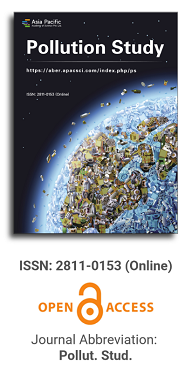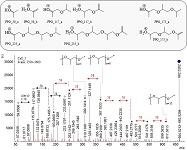
Asia Pacific Academy of Science Pte. Ltd. (APACSCI) specializes in international journal publishing. APACSCI adopts the open access publishing model and provides an important communication bridge for academic groups whose interest fields include engineering, technology, medicine, computer, mathematics, agriculture and forestry, and environment.

The (partial) replacement of synthetic polymers with bioplastics is due to increased production of conventional packaging plastics causing for severe environmental pollution with plastics waste. The bioplastics, however, represent complex mixtures of known and unknown (bio)polymers, fillers, plasticizers, stabilizers, flame retardant, pigments, antioxidants, hydrophobic polymers such as poly(lactic acid), polyethylene, polyesters, glycol, or poly(butylene succinate), and little is known of their chemical safety for both the environment and the human health. Polymerization reactions of bioplastics can produce no intentionally added chemicals to the bulk material, which could be toxic, as well. When polymers are used to food packing, then the latter chemicals could also migrate from the polymer to food. This fact compromises the safety for consumers, as well. The scarce data on chemical safety of bioplastics makes a gap in knowledge of their toxicity to humans and environment. Thus, development of exact analytical protocols for determining chemicals of bioplastics in environmental and food samples as well as packing polymers can only provide warrant for reliable conclusive evidence of their safety for both the human health and the environment. The task is compulsory according to legislation Directives valid to environmental protection, food control, and assessment of the risk to human health. The quantitative and structural determination of analytes is primary research task of analysis of polymers. The methods of mass spectrometry are fruitfully used for these purposes. Methodological development of exact analytical mass spectrometric tools for reliable structural analysis of bioplastics only guarantees their safety, efficacy, and quality to both humans and environment. This study, first, highlights innovative stochastic dynamics equations processing exactly mass spectrometric measurands and, thus, producing exact analyte quantification and 3D molecular and electronic structural analyses. There are determined synthetic polymers such as poly(ethylenglycol), poly(propylene glycol), and polyisoprene as well as biopolymers in bags for foodstuffs made from renewable cellulose and starch, and containing, in total within the 20,416–17,495 chemicals per sample of the composite biopolymers. Advantages of complementary employment in mass spectrometric methods and Fourier transform infrared spectroscopy is highlighted. The study utilizes ultra-high resolution electrospray ionization mass spectrometric and Fourier transform infrared spectroscopic data on biodegradable plastics bags for foodstuffs; high accuracy quantum chemical static methods, molecular dynamics; and chemometrics. There is achieved method performance |r| = 0.99981 determining poly(propylene glycol) in bag for foodstuff containing 20,416 species and using stochastic dynamics mass spectrometric formulas. The results highlight their great capability and applicability to the analytical science as well as relevance to both the fundamental research and to the industry.
The effects of PM2.5 contamination on the health of Chinese residents and the assessment of associated economic losses
Vol 1, Issue 1, 2020
Download PDF
Abstract
A proper evaluation of the health risks and economic burden incurred by urban residents due to air pollution is crucial for regional air pollution management, the formulation and execution of environmental policies, and the promotion of public health in China. Utilizing data on PM2.5 concentration and population density from 338 Chinese cities between 2015 and 2017, this study employs the Exposure-Response model to estimate the premature mortality and disease incidence linked to PM2.5 exposure. It also assesses the direct economic losses associated with PM2.5 pollution using the Value of Statistical Life (VSL) and Cost of Illness (COI) approaches. The findings indicate that: 1) Between 2015 and 2017, there was a slight improvement in PM2.5 concentration levels, yet the overall spatial distribution of pollution remained largely unchanged. The most polluted areas were concentrated in the Beijing-Tianjin-Hebei region and adjacent cities; 2) PM2.5 pollution has resulted in substantial reductions in both health and economic losses. Specifically, the number of residents affected by severe health issues due to pollution decreased by 23.9%, and the total economic loss for residents decreased by 24.24%, from 1824.96 billion yuan in 2015 to 1382.64 billion yuan in 2017; 3) The rising urbanization rate has intensified the health impacts and economic costs of PM2.5 pollution, particularly in cities with both high pollution levels and high urbanization rates, such as Beijing and Tianjin. Moving forward, it is imperative to implement tailored measures to enhance PM2.5 monitoring and control in key cities, thereby effectively safeguarding the health of urban residents.
Keywords
References
- Guan Y, Kang L, Wang Y, et al. Health loss attributed to PM2.5 pollution in China’s cities: Economic impact, annual change and reduction potential. Journal of Cleaner Production. 2019; 217: 284-294. doi: 10.1016/j.jclepro.2019.01.284
- Diao B, Ding L, Zhang Q, et al. Impact of Urbanization on PM2.5-Related Health and Economic Loss in China 338 Cities. International Journal of Environmental Research and Public Health. 2020; 17(3): 990. doi: 10.3390/ijerph17030990
- Fischer PH, Marra M, Ameling CB, et al. Air Pollution and Mortality in Seven Million Adults: The Dutch Environmental Longitudinal Study (DUELS). Environmental Health Perspectives. 2015; 123(7): 697-704. doi: 10.1289/ehp.1408254
- Tie X, Cao J. Aerosol pollution in China: Present and future impact on environment. Particuology. 2009; 7(6): 426-431. doi: 10.1016/j.partic.2009.09.003
- Maji KJ, Ye WF, Arora M, et al. PM2.5-related health and economic loss assessment for 338 Chinese cities. Environment International. 2018; 121: 392-403. doi: 10.1016/j.envint.2018.09.024
- Li J, Zhu Y, Kelly JT, et al. Health benefit assessment of PM2.5 reduction in Pearl River Delta region of China using a model-monitor data fusion approach. Journal of Environmental Management. 2019; 233: 489-498. doi: 10.1016/j.jenvman.2018.12.060
- Han L. Research Progress on urbanization and PM spatial-temporal pattern evolution and its influencing factors. Progress in geographical science. 2018; 37(8): 1011-1021.
- Lu X, Lin C, Li W, et al. Analysis of the adverse health effects of PM2.5 from 2001 to 2017 in China and the role of urbanization in aggravating the health burden. Science of The Total Environment. 2019; 652: 683-695. doi: 10.1016/j.scitotenv.2018.10.140
- Zivin JG, Neidell M. The Impact of Pollution on Worker Productivity. American Economic Review. 2012; 102(7): 3652-3673. doi: 10.1257/aer.102.7.3652
- Hanna R, Oliva P. The effect of pollution on labor supply: Evidence from a natural experiment in Mexico City. Journal of Public Economics. 2015; 122: 68-79. doi: 10.1016/j.jpubeco.2014.10.004
- Deryugina T, Heutel G, Miller N, et al. The Mortality and Medical Costs of Air Pollution: Evidence from Changes in Wind Direction. National Bureau of Economic Research; 2016. doi: 10.3386/w22796
- Pope CA, Ezzati M, Dockery DW. Fine-Particulate Air Pollution and Life Expectancy in the United States. New England Journal of Medicine. 2009; 360(4): 376-386. doi: 10.1056/nejmsa0805646
- Pérez L, Sunyer J, Künzli N. Estimating the health and economic benefits associated with reducing air pollution in the Barcelona metropolitan area (Spain). Gaceta Sanitaria. 2009; 23(4): 287-294. doi: 10.1016/j.gaceta.2008.07.002
- Li H, Zhou D, Wei Y. Health risk and economic loss assessment of urban PM2.5 pollution in China. Environmental Science. 2018; 39(8): 3467-3475.
- Xie Z, Qin Y, Zheng Z, et al. Death effect assessment of PM2.5 pollution in Beijing, Tianjin and Hebei. Journal of environmental science. 2019; 39(3): 843-852.
- Crouse DL, Peters PA, Hystad P, et al. Ambient PM2.5, O3, and NO2 Exposures and Associations with Mortality over 16 Years of Follow-Up in the Canadian Census Health and Environment Cohort (CanCHEC). Environmental Health Perspectives. 2015; 123(11): 1180-1186. doi: 10.1289/ehp.1409276
- Fang D, Wang Q, Li H, et al. Mortality effects assessment of ambient PM2.5 pollution in the 74 leading cities of China. Science of The Total Environment. 2016; 569-570: 1545-1552. doi: 10.1016/j.scitotenv.2016.06.248
- Jaafar H, Razi NA, Azzeri A, et al. A systematic review of financial implications of air pollution on health in Asia. Environmental Science and Pollution Research. 2018; 25(30): 30009-30020. doi: 10.1007/s11356-018-3049-0
- Zeng X, Xie F, Zong Q. Behavior choice and willingness to pay for reducing PM2.5 health risk—a case study of Beijing residents. China population, resources and environment. 2015; 25(1): 127-133
- Huang D, Zhang S. Health benefit evaluation of PM2.5 pollution control in Beijing Tianjin Hebei region. China Environmental Science. 2013; 33(1): 166-174.
- Li H, Zhou D, Wei Y. Research Progress on health economic loss assessment of air pollution. Environmental science research. 2020; 33(10): 2421-2429
- Xie Y, Dai H. Impact of PM2.5 pollution on population health and economy in Beijing Tianjin Hebei region. China population, resources and environment. 2016; 26(11): 19-27.
- Wang G, Wu L, Chen J, et al. CGE Analysis of health and economic effects of PM2.5 pollution in Beijing. China Environmental Science. 2017; 37(7): 2779-2785.
- Zeng X, Ruan F. National economic impact analysis of health effects of PM2.5 pollution in China. China Environmental Science. 2020; 40(7): 3228-3238.
- Fu C, Wang W, Tang J, et al. Study on spatial population distribution of PM2.5 health risk—a case study of Shenzhen. China soft science. 2014; (9): 78-91.
- Du Y, Wan Q, Liu H, et al. How does urbanization influence PM2.5 concentrations? Perspective of spillover effect of multi-dimensional urbanization impact. Journal of Cleaner Production. 2019; 220: 974-983. doi: 10.1016/j.jclepro.2019.02.222
- Liu M, Huang Y, Jin Z, et al. The nexus between urbanization and PM2.5 related mortality in China. Environmental Pollution. 2017; 227: 15-23. doi: 10.1016/j.envpol.2017.04.049
- Wang Q, Wang J, He MZ, et al. A county-level estimate of PM 2.5 related chronic mortality risk in China based on multi-model exposure data. Environment International. 2018; 110: 105-112. doi: 10.1016/j.envint.2017.10.015
- Li T, Zhang Y, Wang J, et al. All-cause mortality risk associated with long-term exposure to ambient PM2.5 in China: a cohort study. The Lancet Public Health. 2018; 3(10): e470 -e477.
- Zheng Y, Zhang Q, Liu Y, et al. Estimating ground-level PM2.5 concentrations over three megalopolises in China using satellite-derived aerosol optical depth measurements. Atmospheric Environment. 2016; 124: 232-242. doi: 10.1016/j.atmosenv.2015.06.046
- Wang G, Gu S, Chen J, et al. Assessment of health and economic effects by PM2.5pollution in Beijing: a combined exposure–response and computable general equilibrium analysis. Environmental Technology. 2016; 37(24): 3131-3138. doi: 10.1080/09593330.2016.1178332
- Bagan H, Yamagata Y. Analysis of urban growth and estimating population density using satellite images of nighttime lights and land-use and population data. GIScience & Remote Sensing. 2015; 52(6): 765-780.
- Apte JS, Brauer M, Cohen AJ, et al. Ambient PM2.5 Reduces Global and Regional Life Expectancy. Environmental Science & Technology Letters. 2018; 5(9): 546-551. doi: 10.1021/acs.estlett.8b00360
- Apte JS, Marshall JD, Cohen AJ, et al. Addressing Global Mortality from Ambient PM2.5. Environmental Science & Technology. 2015; 49(13): 8057-8066. doi: 10.1021/acs.est.5b01236
- Dockery DW, Pope CA, Xu X, et al. An Association between Air Pollution and Mortality in Six U.S. Cities. New England Journal of Medicine. 1993; 329(24): 1753-1759. doi: 10.1056/nejm199312093292401
- Xie Y, Dai H, Dong H, et al. Economic Impacts from PM2.5 Pollution-Related Health Effects in China: A Provincial-Level Analysis. Environmental Science & Technology. 2016; 50(9): 4836-4843. doi: 10.1021/acs.est.5b05576
- Pope III CA. Lung Cancer, Cardiopulmonary Mortality, and Long-term Exposure to Fine Particulate Air Pollution. JAMA. 2002; 287(9): 1132. doi: 10.1001/jama.287.9.1132
- Yang Z, Liu P, Xu X. Estimation of social value of statistical life using willingness-to-pay method in Nanjing, China. Accident Analysis & Prevention. 2016; 95: 308-316. doi: 10.1016/j.aap.2016.04.026
- Puig-Junoy J, Ruiz Zamora A. Socio-economic costs of osteoarthritis: A systematic review of cost-of-illness studies. Seminars in Arthritis and Rheumatism. 2015; 44(5): 531-541. doi: 10.1016/j.semarthrit.2014.10.012
- Du W, Feng K. Will urbanization worsen air quality—Empirical evidence from emerging economies. Comparison of economic and social systems. 2013; (5): 91-99.
- Wang S, Fang C, Guan X, et al. Urbanisation, energy consumption, and carbon dioxide emissions in China: A panel data analysis of China’s provinces. Applied Energy. 2014; 136: 738-749. doi: 10.1016/j.apenergy.2014.09.059
- Shao S, Li X, Cao J. Urbanization promotion and smog control in China. Economic research. 2019; 54(2): 148-165.
- Wangdewen Changes in labor supply and demand at the stage of low fertility and China’s economic growth. China Population Science, 2007 (1): 44-52.
- Xie X. The value of health: environmental benefit assessment method and urban air pollution control strategy. Beijing: Peking University; 2011.
- Viscusi WK, Magat WA, Huber J. Pricing environmental health risks: survey assessments of risk-risk and risk-dollar trade-offs for chronic bronchitis. Journal of Environmental Economics and Management. 1991; 21(1): 32-51.
- Chen X. Value assessment of health damage caused by atmospheric particles. Xiamen: Xiamen University; 2008.
- Fang C. The evolution and adjustment of China’s urban development policy and the new pattern of urban scale. Geographical research. 2014; 33(4): 674-686.
Supporting Agencies
Copyright (c) 2020 Lei Ding, Xuejuan Fang, Kunlun Chen

This work is licensed under a Creative Commons Attribution 4.0 International License.

This site is licensed under a Creative Commons Attribution 4.0 International License (CC BY 4.0).
.jpg)
Beijing University of Technology, China



